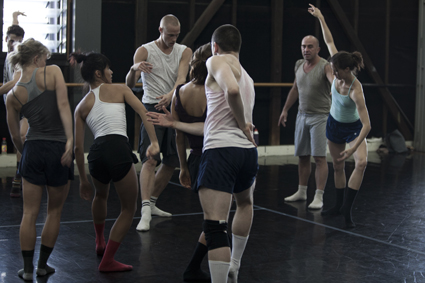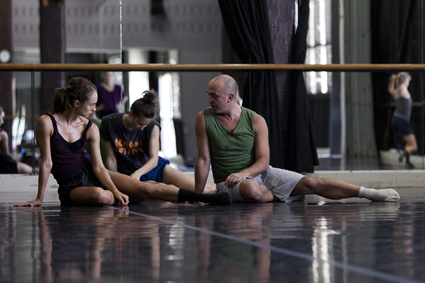the human as animal
erin brannigan: interview, choreographer jacopo godani

Jacopo Godani (R) rehearsing with SDC Dancers
photo Peter Greig
Jacopo Godani (R) rehearsing with SDC Dancers
ITALIAN CHOREOGRAPHER JACOPO GODANI IS CURRENTLY IN SYDNEY TO CHOREOGRAPH A NEW WORK, RAW MODELS, FOR THE SYDNEY DANCE COMPANY. THE PIECE FORMS ONE HALF OF A DOUBLE BILL, SHARED FREQUENCIES, THE OTHER HALF BEING RAFAEL BONACHELA’S LANDFORMS. ERIN BRANNIGAN SPOKE WITH GODANI IN THE MIDST OF HIS PREPARATIONS.
I’m very interested in the overall approach you take to the choreography, the lighting and the design, your authorship over the entire work. You studied Fine Arts and Dance. Were you doing these at the same time?
I was in Italy and, yes, I did start dancing on a very quiet level in the last two years of my studies in Fine Art, but then I finally managed to go to the Maurice Béjart School and I could slow down with the fine arts to dedicate more time to dance. I started [dance] really late so I had to work all day, every day.
It was straight out of that that you set up your own company in 1990?
A couple of years later. I went to work with a small contemporary dance group in Paris for one year and then eight months back in Belgium with a new group that was a bit post-Béjart. And in that group I asked if I could do a work, which went well and we went on tour with it. And then a director of a theatre in Brussels saw it and offered me a residency…
That was an exciting time in Brussels with artists like De Keersmaeker, Vandekeybus and Alain Platel emerging and experimenting in collective environments.
It was fantastic…Money for culture, support and, most of all, curiosity. They were not creating a market or an economy. I don’t think they were making money but, culturally I mean, they were one of the most important movements in Europe in those years.
The Rosas School (P.A.R.T.S) that came out of that moment—where an artist was able to set up a training institution—was very idealistic and follows De Keersmaeker’s particular vision. For that to happen now, here…
Impossible. I work with a lot of companies in Europe. A lot of people ask me, “Why don’t you have your own company?” I would love to but right now with the frequency of work I have and the intensity…I do everything myself—lights, costumes, staging and choreography. And I am participating in the creation of the music and sometimes I do video design as well. When you’re a professional artist, you know how to deal with many fields. You don’t need 20 years company formation for everything you do. But right now, if I were to think about which country to set up a base to ask for an amount of money to carry on a philosophy with a group of dancers, I wouldn’t know where to do that.
So you don’t have any of the responsibility of having to raise funds or be responsible for a company of dancers. And the benefit outweighs the fact that you’re starting afresh with virtually a new company each time? Or are you invited into companies where you know what you’re dealing with to a certain extent?
I’m invited into companies regularly but you know how it is, dancers come and go all the time, especially in big companies. And dancers have other experiences and forget about what they have gone through with you. So you have to restart anyway. In that way, it’s a bit frustrating.
I don’t know how many of the dancers can tell you having worked with Jacopo has been an important experience or not. I think within the context of the limited time we have together, I challenge them a lot really. It’s quite an interesting ‘weapon’ to work with, dance, first of all because of the openness there is to receiving information. The dancer is really one of the most dedicated interpreters in the art world. In this way you can influence—in a very positive way—people’s way of seeing things. And this doesn’t only involve ideas. It involves mental mechanics. Because of the bodily involvement I think this goes much deeper, much further than just simply experiencing something that opens your mind.

Jacopo Godani (R) rehearsing with SDC Dancers
photo Peter Greig
Jacopo Godani (R) rehearsing with SDC Dancers
This idea that there’s a much closer link between thinking and the body, this is something you must have found in working with William Forsythe who really requires dancers who are very engaged and independent. How was that time?
It was absolutely amazing. I still dream about it and I left in 2000 so it’s 11 years now.
You were with him for ten years.
When you find a company like his, you don’t go somewhere else! It was the best of the best. There was everything there from avant-garde classical dancing to, the next day, singing in a parody of a musical and then, next day [undertaking] research into wearing sneakers and developing improvisational skills. It was incredible what Bill achieved. Utopian probably. He managed to have a group of 40 people in an opera house where basically there was only space for big stuff and ‘entertaining’ things. But his genius was to be able to make big shows with avant-garde ideas at the same time.
And his dancers … intelligent, definitely, but also very spontaneous because Bill had no parameters. That’s where I learned somehow that we could be free.
At that time the common logic was to shape yourself in circles and lines and angles and go from one to the other, as the step requires. Bill was revolutionary because he made people move like animals, like human beings. Nobody moved like human beings at that time, no matter what contemporary dance style you were looking at. It was about ‘artificialising’ yourself. Bill started to use the body and make it look like a body even though it was dancing classical [ballet]. It was amazing when you saw that.
I was looking at the small video clips online from your works Anomaly 1 (2008) and Spazio-Tempo (2010). There are really quick shifts between still, sculptural moments and really frenetic work.
When you choreograph you can easily be absorbed by looking into mechanics and shapes. And then you let yourself go and you think, “Wow it’s gorgeous!” And I’m so tired of myself. I don’t want to fall into this trap. So now I’m trying to create a type of musicality that is not logical to the brain. I want to get out of a traditional way of seeing beauty and lyricism. I’m sick and tired of doing something like “Lift her and she curls and…Gorgeous!” The dance has to be made because there is an intellectual, physical, mental challenge to produce something creative from dancers’ bodies.
The approach [the dancers] have towards what we are asking is really important. For me there is no creative effort or engagement in [simply] reproducing something correctly. I put [the dancers] in front of the mirror and say, “Do it, look, what do you think? I’m not teaching you this. This is your job. You have to be able to take care of it yourself.”
Let’s talk about Raw Models, your work for Sydney Dance Company. What’s this new work and how does it fit into what you’ve been doing lately?
It fits because I have managed to find a way of moving on even though I’m guest choreographing. I just go from company to company bringing the ‘baggage’ of what I do before. [For instance], I do a small piece of 20 minutes and then I redo it to 45 minutes or something like that. I have four or five weeks here, which is a bit limited unfortunately, so I use the tools that I have access to.
Rafael Bonachela is one of the most important people I’ve met in many years. He’s very alive. We have a very similar energy. We’re very curious. We also like all that there is around the basic artistic production—the networking, the promotional point of view, the contact, speaking to people, interviews—all these things. A lot of artists I find very reluctant about this side of things.
So apart from the music as a starting point [a commissioned score by German duo 48nord], what is this choreographic ‘baggage’ that you’re bringing from your last gig?
I want to create a certain allure around this piece, which is not pretty, lyrical and pleasing. I like the fleshiness and the aggressiveness of humankind and the nature of us as animals. So I’m trying to develop a sort of physicality that is very rough and very eloquent at the same time, by assembling bits of information of all kinds. I’m not trying to make a collage of styles because that’s crap as a concept. I’m trying to develop a piece that has a sort of alien, animalistic universe.
The research that I do choreographically is also structural. I’m also trying to think about light and height at the same time. It’s about the perception of volume. It’s about how to light the space in order to expand it and shrink it and bring it forward and back, [to highlight] all that is involved in a three-dimensional stage space…trying to find a type of light that helps people perceive this.
For a sample of Godani’s previous work, see Spazio-Tempo and Anomaly 1.
Sydney Dance Company, Shared Frequencies: Raw Models, choreographer
Jacopo Godani, composers 48nord; Landforms, choreographer Rafael Bonachela, composer Ezio Bosso; lighting designer Mark Dyson, sound designer Adam Luston; Sydney Theatre, March 29-April 16; www.sydneydancecompany.com
RealTime issue #101 Feb-March 2011 pg. web






